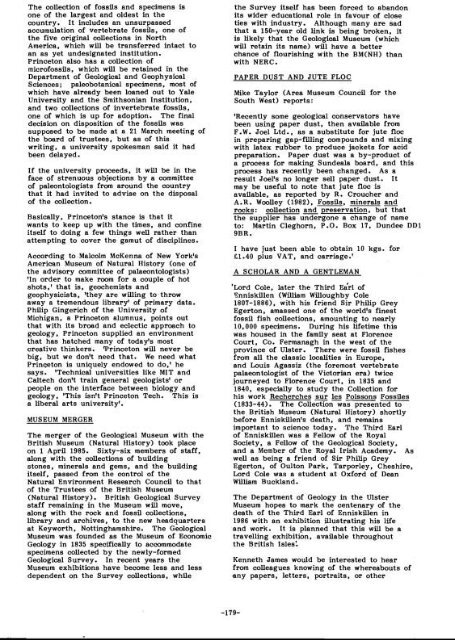Number 3 - Geological Curators Group
Number 3 - Geological Curators Group
Number 3 - Geological Curators Group
Create successful ePaper yourself
Turn your PDF publications into a flip-book with our unique Google optimized e-Paper software.
The collection of fossils and specimens isone of the largest and oldest in thecountry. It includes an unsurpassedaccumulation of vertebrate fossils, one ofthe five original collections in NorthAmerica, which will be transferred intact toan as yet undesignated institution.Princeton also has a collection ofmicrofossils, which will be retained in theDepartment of <strong>Geological</strong> and GeophysicalSciences; paleobotanical specimens, most ofwhich have already been loaned out to YaleUniversity and the Smithsonian Institution,and two collections of invertebrate fossils,one of which is up for adoption. The finaldecision on disposition of the fossils wassupposed to be made at a 21 March meeting ofthe board of trustees, but as of thiswriting, a university spokesman said it hadbeen delayed.If the university proceeds, it will be in theface of strenuous objections by a committeeof paleontologists from around the countrythat it had invited to advise on the disposalof the collection.Basically, Princeton's stance is that itwants to keep up with the times, and confineitself to doing a few things well rather thanattempting to cover the gamut of disciplines.According to,Malcolm McKenna of New YorkfsAmerican Museum of Natural History (one ofthe advisory committee of palaeontologists)'In order to make room for a couple of hotshots.' that is, geochemists andgeophysicists. 'they are willing to.throwaway a tremendous library' of primary data.Philip Gingerich of the University ofMichigan, a Princeton alumnus, points outthat with its broad and eclectic approach togeology. Princeton supplied an environmentthat has hatched many of today's mostcreative thinkers. Trinceton will never bebig, but we don't need that. We need whatPrinceton is uniquely endowed to do.' hesays. 'Technical universities like MIT andCaltech don't train general geologists' orpeople on the interface between biology andgeqlogy, 'This isn't Princeton Tech. This isa liberal arts universityf.MUSEUM MERGERThe merger of the <strong>Geological</strong> Museum with theBritish Museum (Natural History) took placeon 1 April 1985. Sixty-six members of staff,along with the collections of buildingstones, minerals and gems, and the buildingitself. passed from the control of theNatural Environment Research Council to thatof the Trustees of the British Museum(Natural History). British <strong>Geological</strong> Surveystaff remaining in the Museum will move.along with the rock and fossil collections.library and archives, to the new headquartersat Keyworth. Nottinghamshire. The <strong>Geological</strong>Museum was founded as the Museum of EconomicGeology in 1835 specifically to accommodatespecimens collected by the newly-formed<strong>Geological</strong> Survey. In recent years theMuseum exhibitions have become less and lessdependent on the Survey collections, whilethe Survey itself has been forced to abandonits wider educational role in favour of closeties with industry. Although many are sadthat a 150-year old link is being broken, itis likely that the <strong>Geological</strong> Museum (whichwill retain its name) will have a betterchance of flourishing with the BM(NH) thanwith NERC.PAPER DUST AND JUTE FLOCMike Taylor (Area Museum Council for theSouth West) reports:'Recently some geological conservators havebeen using paper dust, then available fromF. W. Joel Ltd., as a substitute for jute floc in preparing gap-filling compounds and mixing with latex rubber to produce jackets for acid preparation. Paper dust was a by-product of a process for making Sundeala board, and this process has recently been changed. As a result Joells no longer sell paper dust. It may be useful to note that jute floc is available, as reported by R. Croucher and A.R. Woolley (1982). Fossils, minerals androcks: collection and preservation, but thatthe supplier has undergone a change of nameto: Martin Cleghorn. P.O. Box 17. Dundee DD19BR.I have just been able to obtain 10 kgs. for£1.40 plus VAT, and carriage.'A SCHOLAR AND A GENTLEMAN'Lord Cole, later the Third ~irl ofFnniskillen (William Willoughby Cole1807-1886). with his friend Sir Philip GreyEgerton, amassed one of the world's finestfossil fish collections, amounting to nearly10.000 specimens. During his lifetime thiswas housed in the family seat at FlorenceCourt, Co. Fermanagh in the west of theprovince of Ulster. There were fossil fishesfrom all the classic localities in Europe.and Louis Agassiz (the foremost vertebratepalaeontologist of the Victorian era) twicejourneyed to Florence Court, in 1835 and1840, especially to study the Collection forhis work Recherches sur les Poissons Fossiles(1833-44). The Collection was presented tothe British Museum (Natural History) shortlybefore Enniskillen's death, and remainsimportant to science today. The Third Earlof Enniskillen was a Fellow of the RoyalSociety, a Fellow of the <strong>Geological</strong> Society.and a Member of the Royal Irish Academy. Aswell as being a friend of Sir Philip GreyEgerton, of Oulton Park. Tarporley. Cheshire,Lord Cole was a student at Oxford of DeanWilliam Buckland.The Department of Geology in the UlsterMuseum hopes to mark the centenary of thedeath of the Third Earl of Enniskillen in1986 with an exhibition illustrating his lifeand work. It is planned that this will be atravelling exhibition, available throughoutthe British Isles:Kenneth James would be interested to hearfrom colleagues knowing of the whereabouts ofany papers, letters, portraits, or other
















